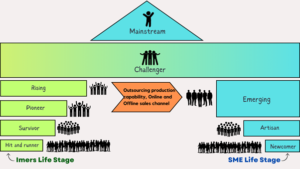In recent years, Micro, Small, and Medium Enterprises (MSMEs) have emerged as the backbone of national economic resurgence. Contributing a significant 60.51% to the country’s GDP, as per data from the Coordinating Ministry for Economic Affairs. Recognizing their pivotal role in the economy, the government is actively promoting the integration of technology within MSMEs to enhance their efficiency and competitiveness. One such initiative involves encouraging MSMEs to embrace the digital landscape.
Simultaneously, another group making waves in the digital realm is Internet Marketers (Imers). Imers engage in internet-based advertising, promoting a variety of products owned by others through platforms like Google Ads, Facebook Ads, and email. In Asia, China leads with a substantial 74% share of internet-based advertising, while Indonesia stands out in Southeast Asia with a notable 30% market penetration.
Small and Medium Enterprises (SMEs) and Imers significantly impact the national economy, both striving to maximise profits through effective promotional strategies. While SMEs tend to sell their own products, Imers initiate their careers by advertising products owned by others. This distinction can be further explored in Table 1.
Table 1. Differences between SMEs and Imers
| Small and Medium Enterprises | Imers | |
| 1 | Produce products or offer services to produce products | Marketing or promoting products |
| 2 | The existence of a certain number of employees has been determined based on the law | There is no provision for the number of employees owned |
| 3 | The existence of a certain amount of net worth that has been determined by law | There is no provision for the amount of net worth owned |
| 4 | Must have a legal entity | No requirement to have a legal entity |
| 5 | Makeshift utilization of technology | Maximum utilization of technology |
| 6 | Regionally-oriented marketing strategy in the area around the store. | Have a more holistic marketing strategy and cover a wider regional scale |
|
7 |
The starting point is in selling one’s own/others’ products offline. |
The starting point is selling other people’s products online |
Interestingly, Imers progressed beyond mere advertising, eventually transitioning to producing their own products. At this juncture, they align more closely with the characteristics of SMEs. The convergence of Imers and SMEs occurs when Imers start creating their products, and SMEs venture into internet-based advertising. This convergence, depicted in Figure 1, underscores their shared character and end goals.
Figure 1.

The figure illustrates five stages in both Imers’ and SMEs’ careers, showcasing how their paths intersect at the Challenger stage. Following this stage, both entities strive for the pinnacle, known as the Mainstream stage. Despite differences in their journeys, reaching this pinnacle requires comparable efforts from Challenger-stage Imers and SMEs.
Recognizing the crucial roles of both Imers and SMEs as engines of economic growth, it is imperative that they receive adequate support and attention from various sectors, particularly from the government. Favourable regulations should be enacted to empower them in their business endeavours. Ultimately, individuals must recognize that each path—whether through the Imers or SME stage—comes with unique challenges and capital requirements, but the ultimate destination remains the same.
Crucially, it’s essential to understand that aspiring entrepreneurs’ chosen paths do not inherently pit one entity against the other. Instead, both Imers and SMEs are vital contributors to the domestic economy. The true competition lies in the form of large foreign investors who can potentially disrupt the local business ecosystem. Collaboration between Imers and SMEs holds the key to success, positioning local entrepreneurs to triumph within their own countries.




